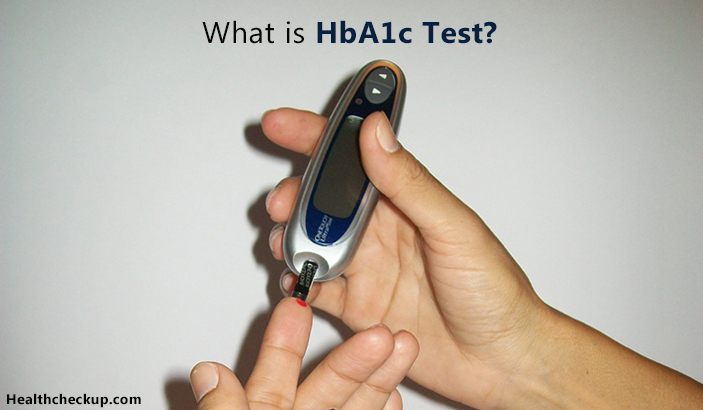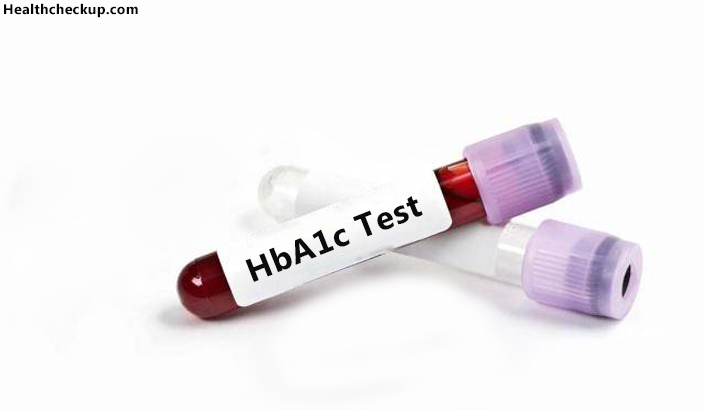What is HbA1c? Hemoglobin A1c, often abbreviated HbA1c, is a form of hemoglobin (a blood pigment that carries oxygen) that is bound to glucose. The blood test for the HbA1c level is routinely performed in people with type 1 and type 2 diabetes mellitus. Blood HbA1c test levels are reflective of how well diabetes is controlled. The normal levels of HbA1c is greater or equal to 6.5 is considered as diabetes. HbA1c also is known as Glycosylated, or Glycated Hemoglobin.
HbA1c levels are reflective of blood glucose levels over the past six to eight weeks and do not reflect daily ups and downs of blood glucose. High HbA1c test levels indicate poorer control of diabetes than levels in the normal range. HbA1c is typically measured to determine how well a type 1 diabetes or type 2 diabetes treatment plan (including medications, exercise, or dietary changes) is working.
Hemoglobin is the oxygen-carrying pigment that gives blood its red color and is also the predominant protein in red blood cells. About 90% of hemoglobin is hemoglobin A (the “A” stands for Adult Type). Although one chemical component accounts for 92% of hemoglobin A, approximately 8% of hemoglobin A is made up of minor components that are chemically slightly different. These minor components include hemoglobin A1c, A1b, A1a1, and A1a2. Hemoglobin A1c (HbA1c) is a minor component of hemoglobin to which glucose is bound. HbA1c also is sometimes referred to as glycated, glycosylated hemoglobin, or glycohemoglobin.
How Is Hemoglobin A1c Measured or What is the Procedure?
The test for hemoglobin A1c depends on the chemical (electrical) charge on the molecule of HbA1c, which differs from the charges on the other components of hemoglobin. The molecule of HbA1c also differs in size from the other components. HbA1c may be separated by charge and size from the other hemoglobin A components in blood by a procedure called high pressure (or performance) liquid chromatography (HPLC). HPLC separates mixtures (for example, blood) into its various components by adding the mixtures to special liquids and passing them under pressure through columns filled with a material that separates the mixture into its different component molecules.
HbA1c testing is done on a blood sample. Because HbA1c is not affected by short-term fluctuations in blood glucose concentrations, for example, due to meals, blood can be drawn for HbA1c testing without regard to when food was eaten. Fasting for the blood test is not necessary.
What Are Normal Levels of Hemoglobin A1c?
In healthy people, the HbA1c test level is less than 6.5% of total hemoglobin. A level of 6.5% signals that diabetes is present. Studies have demonstrated that the complications of diabetes can be delayed or prevented if the HbA1c test level can be kept below 7%. It is recommended that treatment of diabetes be directed at keeping an individual’s HbA1c level as close to normal as possible (<6%) without episodes of hypoglycemia (low blood glucose levels).
What Are High Levels of Hemoglobin A1c?
As mentioned previously, normal levels of HbA1c are less than 6%, so a measurement over 6% is considered high. For many people with type 1 and type 2 diabetes, the goal is to keep the HbA1c levels under 7%, since keeping levels below 7% has been shown to delay the complications of diabetes.
Many laboratories report a calculated eAG (Estimated Average Glucose) along with every HbA1c results. This is a correlation of the HbA1c levels with the average blood sugar level. For example, a HbA1c measurement of 7% corresponds to an eAG measurement of 154 mg/dl.
The American Diabetes Association has a calculator to help you convert your A1c level to the average blood glucose level.
When Should Hemoglobin A1c Levels Be Tested?
In addition to random fasting blood glucose levels, HbA1c levels are routinely measured (tested) in the monitoring of people with type 1 and type 2 diabetes. HbA1c test levels depend on the blood glucose concentration. That is, the higher the glucose concentration in blood, the higher the level of HbA1c. Levels of HbA1c are not influenced by daily fluctuations in the blood glucose concentration but reflect the average glucose levels over the prior six to eight weeks.
Therefore, HbA1c is a useful indicator of how well the blood glucose level has been controlled in the recent past (over two to three months) and may be used to monitor the effects of diet, exercise, and drug therapy on blood glucose in people with diabetes.
How Can a Person Lower Their HbA1c Test Levels?
Following your type 1 or type 2 diabetes management plan can help lower your HbA1c test level. This may consist of
- Dietary modifications
- Physical activity
- Medications
- Combination of these
A normal or only slightly elevated HbA1c test level is an indication that your diabetes is under good control. If your HbA1c test level remains high despite following your treatment plan, your doctor may suggest changing your treatment plan.
What Are the Limitations to Measuring Hemoglobin A1c?
Since HbA1c is not influenced by daily fluctuations in blood glucose concentration, it cannot be used to monitor day-to-day blood glucose concentrations and is inappropriate to be used for adjusting insulin doses; nor can it detect the day-to-day presence or absence of hyperglycemia or hypoglycemia. HbA1c may be increased falsely in certain medical conditions. These conditions include
- Kidney Failure (Uremia)
- Chronic excessive alcohol intake
- Hypertriglyceridemia
- Medical conditions that may falsely decrease HbA1c include
- Acute or chronic blood loss
- Sickle cell disease
- Thalassemia
What Affects the Test?
Reasons you may not be able to have the test or why the results may not be helpful include:
- Having severe blood loss or a blood transfusion in the last 3 months.
- Having certain medical conditions, such as sickle cell anaemia, hemolytic anaemia, some types of thalassemia, and severe kidney disease.
- Having your spleen taken out. This changes the normal life cycle of red blood cells and A1c levels.
What to Keep in Mind
If you have diabetes, your doctor may recommend that you have an A1c test every 3 to 6 months, depending on how well you are meeting your treatment goals. Some people who develop diabetes have normal A1c levels early in the course of their disease. A1c levels can be normal in some people who have untreated diabetes and certain medical conditions, such as sickle cell anaemia, hemolytic anaemia, severe kidney disease, or pregnancy.
A1c levels are not useful for finding low blood sugar (hypoglycemia). The A1c test does not replace the need for other regular blood glucose tests, including checking your blood sugar at home and a regular blood glucose test. Understanding the above facts, you will now know what is the HbA1C test all about.
Medically Reviewed By

I am an experienced Medical/Scientific writer with a passion for helping people live a happy healthy life. My thirst for writing has followed me throughout the years – it is there when I wake up, lingering at the edges of my consciousness during the day, and teases me at night as I go to sleep.










